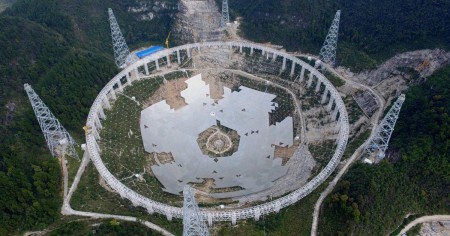
Nine thousand Chinese villagers are being forced to leave their homes to make way for a giant radio telescope to detect extra-terrestrial life.
The Chinese government is relocating villagers around Pingtang to complete construction by September of its 500 metre-diameter Aperture Spherical Telescope – or FAST – at an estimated cost of 1.2 Chinese Yuan (£129m).
The mass relocation was announced on Tuesday in a report by Xinhua, the state news agency. The report said officials were relocating 2,029 families, a total of 9,110 people, living within a three-mile radius of the telescope in the area of Pingtang and Luodian Counties in the southwestern province of Guizhou.
Officials plan to give each person the equivalent of $1,800 for housing compensation, the report said. Guizhou is one of China’s poorest provinces.
Forced relocations for infrastructure projects are common across China, and the people being moved by officials often complain both of the eviction from their homes and inadequate compensation.
The Three Gorges Dam displaced more than one million people along the Yangtze River, and the middle route of the gargantuan South-North Water Diversion Project has resulted in the relocation of 350,000 people to make way for a series of canals.
The Chinese government has announced ambitious plans for its space program, at a time when the American one is in retreat. China aims to put an astronaut on the moon and a space station in orbit. The FAST project is another important element in the larger plan.
If the truth is out there, then some Chinese scientists are confident that the giant telescope will find it. The current largest operational radio telescope is the 300-metre-diameter Arecibo Observatory in Puerto Rico, but FAST in Guizhou will far surpass that.
Li Di, a chief scientist with the National Astronomical Observatories under the Chinese Academy of Sciences, told China Daily last year that “with a larger signal receiving area and more flexibility, FAST will be able to scan two times more sky area than Arecibo, with three to five times higher sensitivity.”
Last November, scientists successfully tested the telescope’s “retina,” which weighs 33 tons and is suspended 460 to 525 feet above the reflector dish, which was half-finished at the time.









